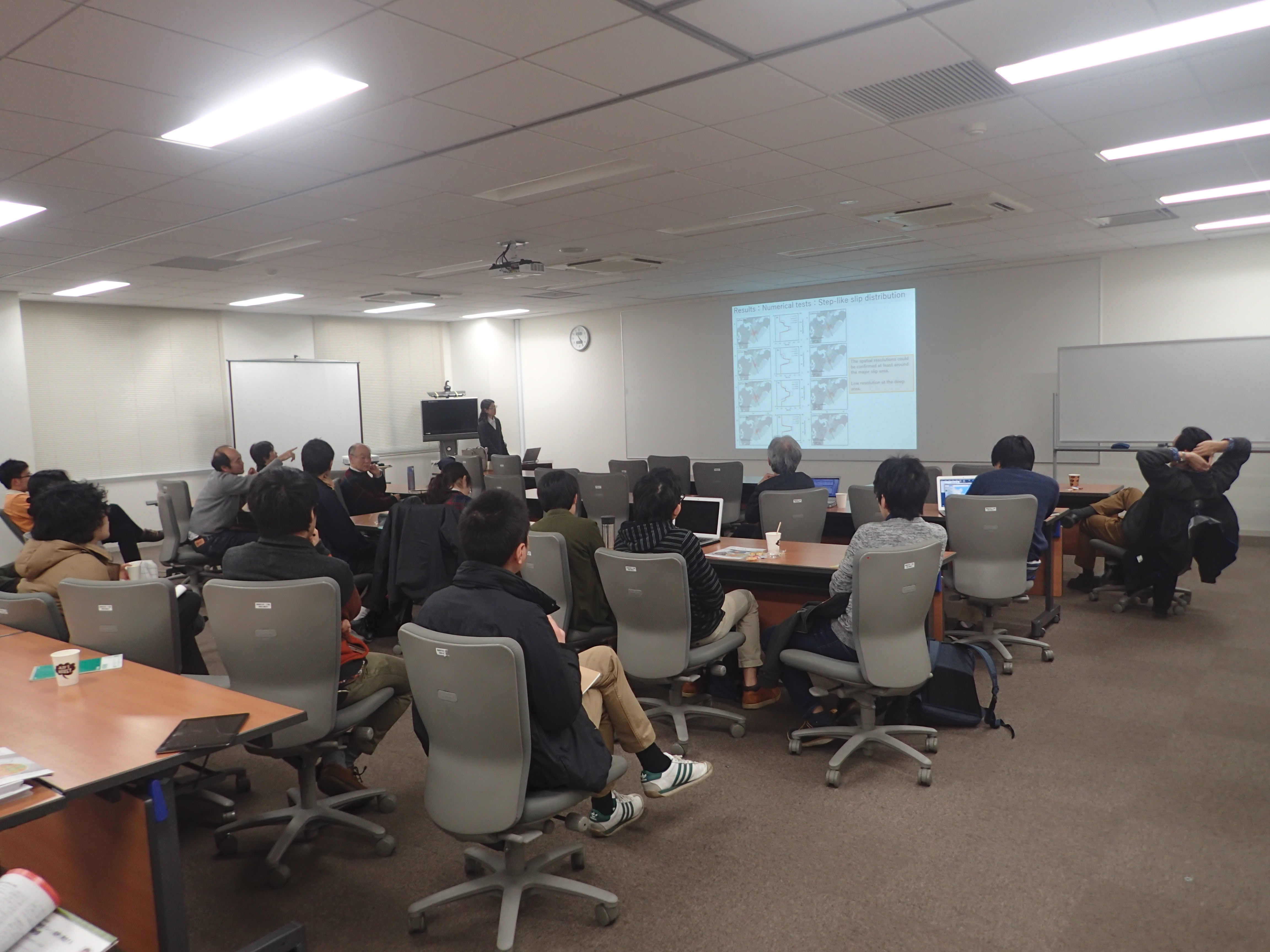集会等トピックス2018年
2018/12/10-14
AGU Fall Meeting 2018でスロー地震学関連セッションが開催されました。
| 学会名 | AGU Fall Meeting 2018 (公式WEB) |
|---|---|
| 日時 | 2018年12月10-14日 |
| 投稿締切 | 2018年8月1日 |
| 会場 | Walter E. Washington Convention Center |
| 詳細 | スロー地震学関連セッション: T025. Interplay between seismic and aseismic slip: Implications for fault physics Section/Focus Group: Tectonophysics T042. Subduction zone processes at the Hikurangi margin, New Zealand Section/Focus Group: Tectonophysics |
2018/12/04
中高生向けの講演を行いました。
| 日時 | 2018年12月4日(火)13:30~14:30 |
|---|---|
| 会場 | 東京大学地震研究所2号館第1会議室:アクセスMAP |
| 話者 | 小原一成(東大地震研) |
| 演題 | 「スロー地震の発見とその意義」 |
2018/12/03
「スロー地震学の創成」特別シンポジウムを開催しました。
| 日時 | 2018年12月3日(月)15:00~17:00 |
|---|---|
| 会場 | 東京大学 山上会館2階大会議室:アクセスMAP |
| プログラム | 15:00-16:00 基調講演「スロー地震学の創成」小原一成(東大地震研) 16:15-16:50 パネルディスカッション「スロー地震学の今後の展望」 司会:加藤愛太郎(東大地震研) パネラー:小原一成(東大地震研)、平田直(東大地震研)、西村卓也(京大防災研、麻生尚文(東京工業大) |
2018/10/29
「スロー地震カフェ」を開催しました。
話題提供者は、McGill UniversityのNoah Phillipsさんです。開始30分前に開場しますので、話題提供者や他の参加者とご歓談ください
多くの皆さんのご参加をお待ちしております。
| 日時 | 2018年10月29日(月)16:00~17:30(15:30開場) |
|---|---|
| 会場 | 東京大学地震研究所1号館セミナー室:アクセスMAP |
| 話題提供者 | Noah Phillipsさん(McGill University) |
| 話題 | "The Life and Death of Frictional Melts (Earthquakes) in the Rock Record: Implications for the Short- and Long-Term Strength of Faults" |
| 要旨 | During earthquakes, a number of co-seismic weakening mechanisms are responsible for decreasing fault strength, one of which is frictional melting. Upon crystallization, frictional melts become a strong layer of glass (pseudotachylyte). Previous experiments using dry, felsic lithologies as starting material have shown that pseudotachylytes can be as strong as their host rock, deterring re-activation and favouring their preservation over geologic time. However, we show that where fluid is present, pseudotachylyte can be replaced by phyllosilicate-rich layers with a low frictional strength. The rate of dissolution is dependent on the bulk composition of the pseudotachylyte, with dissolution of mafic glasses occurring at least three orders of magnitude faster than felsic glasses. Under hydrothermal conditions, the replacement of pseudotachylytes by layers of frictionally weak phyllosilicates is predicted to occur over time intervals shorter than the megathrust earthquake cycle. This process likely reduces fault strength and promotes reactivation. |
2018/10/20
東京大学ホームカミングデイで小原一成領域代表が講演しました。
| 講演会 | スロー地震:ホームカミングディ公式WEB |
|---|---|
| 日時 | 2018年10月20日 11:00~12:00 |
| 会場 | 東京大学地震研究所1号館2階セミナー室:アクセスMAP |
| 内容 | 近年、注目されるようになってきたスロー地震について、発見の背景や経緯、活動の特徴、世界的な研究の進展について紹介するとともに、スロー地震が巨大地震とどのように関わるかについてその可能性を解説する。 |
2018/10/19
第79回 知の拠点セミナー(国立大学共同利用・共同研究拠点協議会)で小原一成領域代表が講演しました。
| セミナー名 | 第79回 知の拠点セミナー(国立大学共同利用・共同研究拠点協議会) (公式WEB) |
|---|---|
| 日時 | 2018年10月19日 18:00~20:00 |
| セミナー申込 | 締切:2018年10月17日(水) 16時まで (定員に達し次第締め切ります) ※申込詳細は上記リンクからご確認ください。 |
| 会場 | 東京大学地震研究所1号館2階セミナー室:アクセスMAP |
| プログラム | 講演1:「同位体組成が記録する地球型惑星の形成環境」 講演2:「スロー地震の発見とその意義」 |
2018/10/09-11
日本地震学会2018年度秋季大会でスロー地震学関連セッションが開催されます。
| 学会名 | 日本地震学会2018年度秋季大会 (公式WEB) |
|---|---|
| 日時 | 2018年10月9-11日 |
| 講演受付開始 | 2018年6月27日 |
| 会場 | ビッグパレットふくしま |
| 詳細 | スロー地震学関連セッション:「地震活動とその物理」 趣旨: 幅広い時空間スケールにまたがる地震活動(スロー地震を含む)の現象論的側面の研究はもちろん、その物理的理解を深めるための実験的あるいは理論的研究と観測研究の融合、統計モデルや力学モデル、データ駆動型科学等を用いた地震活動の再現や予測の研究を歓迎する。 |
2018/10/01
「スロー地震カフェ」を開催しました。
話題提供者は、University of Southern CaliforniaのHeidi Houstonさんです。
多くの皆さんのご参加をお待ちしております。
| 日時 | 2018年10月1日(月)16:00~17:30(15:30開場) |
|---|---|
| 会場 | 東京大学地震研究所1号館セミナー室:アクセスMAP |
| 話題提供者 | Heidi Houstonさん(University of Southern California) |
| 話題 | "Evolution of stress and strength through slow slip and tremor cycles" |
| 要旨 | Slow slip extended updip of tremor during six large (M~6.8) ETSs in northern Cascadia, based on inversions of GPS displacements with a realistic plate interface. Our results (Hall, Houston and Schmidt, 2018, G-cubed) indicate that slow slip of up to 2 cm extends updip of tremor by about 15 km beneath the Olympic Peninsula. In these ETSs, slow slip extends from the downdip portion of the tremorgenic region beyond the updip extent of tremor, although still downdip of the inferred locked megathrust. Slip updip of tremor is a persistent feature of all six ETS events. Restricted inversions that permit slip to occur only in the regions that generated tremor produced slip distributions with unphysical characteristics, such as 8 cm slip concentrated at the updip part of the tremor footprint. I will discuss two interpretations of this observation. First, farther updip tremor is possible, but has not yet been seen due to the limited observation period. Alternatively, physical conditions (such as pore pressure differences), for example, controlled by the intersection of the crustal Moho with the plate interface, prohibit tremor from occurring updip of that intersection even during substantial slow slip. The first interpretation would follow from an updip extrapolation of observed along-dip trends. Tremor and LFE activity become less frequent towards the updip region, occurring only during the large ETSs (e.g., Wech and Creager, 2011; Sweet, PhD thesis, 2014). This implies that the difference between the strength and stress of tremorgenic patches increases updip, requiring larger stress perturbations to fail. It further suggests that farther updip tremor will eventually be observed during an even larger, but less frequent, ETS than seen so far in the limited record. Although it is appealing to extrapolate these observed along-dip trends, it should be noted that long-term SSEs in Nankai do not appear to activate tremor updip of where it occurs in short-term SSEs, supporting the second interpretation. In either case, the observation of episodic slow slip farther updip than tremor in Cascadia implies that strain in that region adjacent to the megathrust is accumulating more slowly than we might otherwise infer. We further explore how fault stress evolves on the Cascadia megathrust during an ETS, with time-dependent inversions of the 2010 and 2012 events, which propagated along strike in opposite directions under northern Washington. For both events, the slip-pulse nature of the ETS process is clearly imaged by the inversions, with fault patches continuing to slip for several days, but not through the entire duration of the event. Notably, for both events, i.e., for opposite along-strike propagations directions, small amounts of tremor are observed occurring ahead of the slipping region. We hypothesize that the initial bursts of tremor are triggered by the small leading stresses ahead of the propagating slip pulse. Integrated with other observations including tremor sensitivity to tidal stresses (e.g., Houston, 2015), the overall stress drop of the ETSs, and observed along-dip trends in LFE/tremor recurrence periods, the slip inversion results provide additional constraints on stress and strength evolution during large ETSs. I will discuss models of the evolution of strength and stress through entire slow slip cycles that are consistent with observed along-dip trends. |
2018/09/26
「スロー地震学特別セミナー@つくば」を開催しました。
| 日時 | 2018年9月26日(水)10:30~11:30 |
|---|---|
| 会場 | 防災科研 研究交流棟1階 第1セミナー室:アクセスMAP |
| 講演者 | Prof. Geoffrey Abers (Cornell University) |
| タイトル | "Recent Cascadia work, related to a volcano project" |
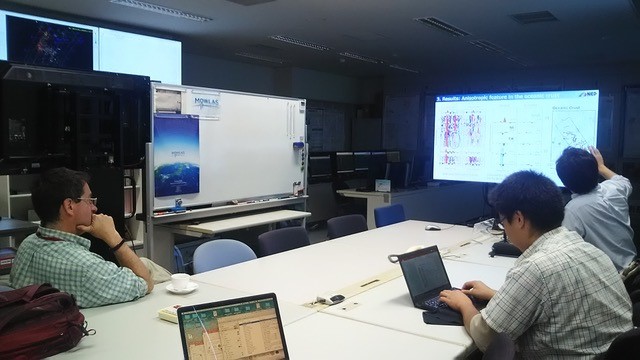
2018/09/26
「スロー地震カフェ」を開催しました。
話題提供者は、U.S. Geological SurveyのDavid Shellyさんです。
多くの皆さんのご参加をお待ちしております。
| 日時 | 2018年9月26日(水)10:30~11:30 |
|---|---|
| 会場 | 東京大学地震研究所1号館セミナー室:アクセスMAP |
| 話題提供者 | David Shellyさん(U.S. Geological Survey) |
| 話題 | "Earthquake swarms in high definition: migrating seismicity and fluid-faulting interactions beneath Long Valley Caldera, California" |
| 要旨 | Earthquake swarms are common signatures of unrest in both volcanic and tectonic environments. Their interpretation rests upon an understanding of underlying physical processes, yet routine network processing typically provides limited information in this regard. To address this issue, we have developed waveform-based processing that leverages the existing catalog of earthquakes to detect and characterize events absent in routine catalogs. Using large-scale waveform cross-correlation between cataloged events with the continuous data stream, it's possible to detect and precisely locate many times more events than are included in standard catalogs. We have recently extended this technique estimate relative polarities between events, facilitating robust focal mechanism estimation for large populations of tiny earthquakes, addressing a common shortcoming in microseismicity analyses (Shelly et al., JGR, 2016). Application to a 2014 swarm in Long Valley Caldera, California, illuminates complex patterns of faulting that would have otherwise remained obscured. Together, these patterns imply strong interactions between fluid diffusion and faulting processes in the crust. |
2018/09/25
「スロー地震カフェ」を開催しました。
話題提供者は、University of California, BerkeleyのNoel Bartlowさんです。
多くの皆さんのご参加をお待ちしております。
| 日時 | 2018年9月25日(火)15:30~17:00(15:00開場) |
|---|---|
| 会場 | 東京大学地震研究所1号館セミナー室:アクセスMAP |
| 話題提供者 | Noel Bartlowさん(University of California, Berkeley) |
| 話題 | "Mechanics of slow slip events in Cascadia and New Zealand" |
| 要旨 | The Cascadia subduction zone in the U.S. and the Hikurangi subduction zone in New Zealand both host slow slip events, but with very different properties including durations, depths, slip amplitudes, and presence of tremor. In this seminar I will review the results from a variety of recent and ongoing studies from both subduction zones, with a focus on applying existing and novel geodetic techniques. I will also discuss the implications of these studies for the mechanics of slow slip and tremor in each subduction zone, and the potential of Episodic Tremor and Slip (slow slip and tremor) events in Cascadia to trigger the next large earthquake in the locked zone. In Cascadia, the tight correlation between slow slip and tremor (Bartlow et al., 2011) provides constraints on the location and timing of expected slow slip signals in geodetic data, allowing me to stack slow slip events and study their cumulative effects in with unprecedented spatial detail. This technique is also useful for constraining plate motions in southern Cascadia, an area with many complex sources of tectonic deformation. I show that in Cascadia, geodetically detectable slow slip is concentrated on the updip end of the tremor region, and over the last 10-20 years slow slip events have only accommodated about half as much slip as would be necessary to keep up with the plate convergence rate. Significant along-strike variations in slow slip behavior are seen in both subduction zones which appear to correlate with some known structures or variations in physical properties along strike. 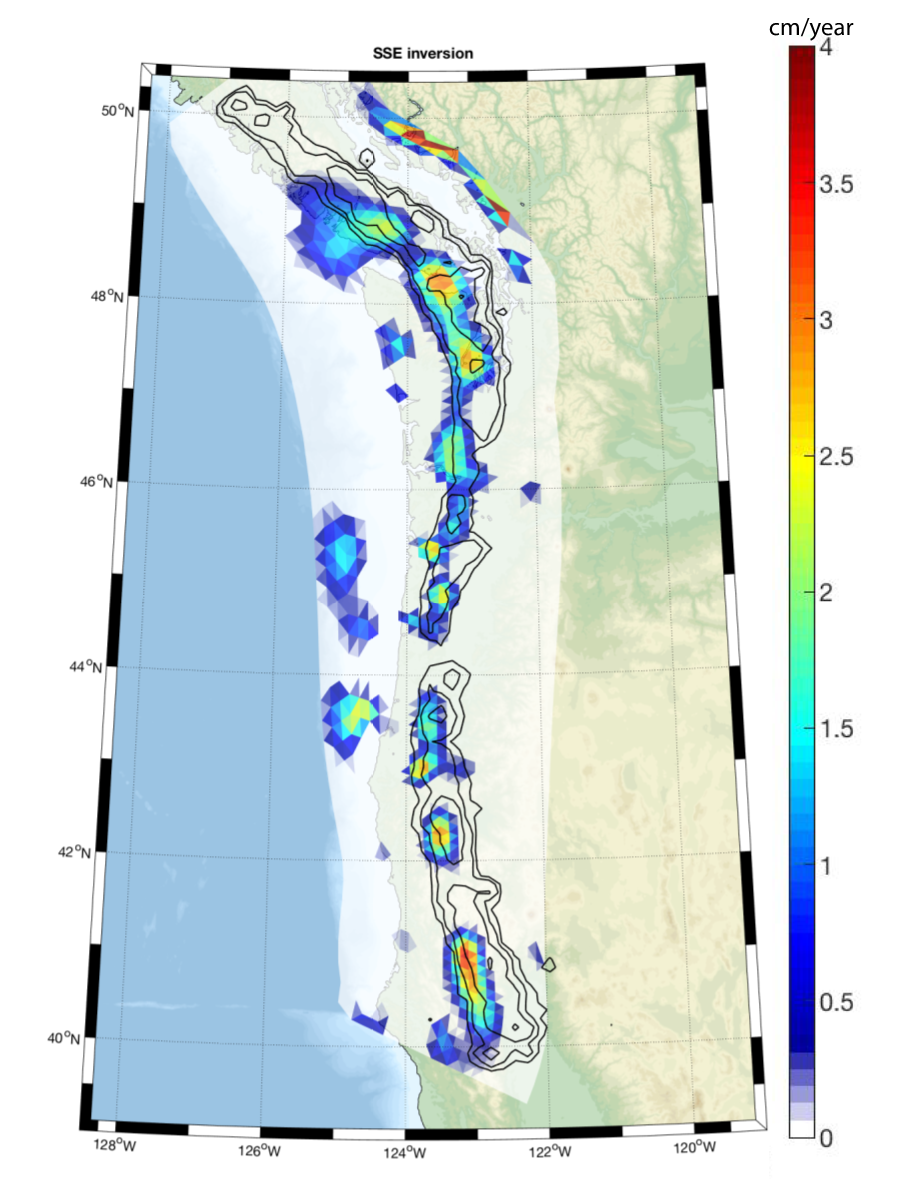 Time-averaged slow slip velocity on the Casacadia plate interface (colors) compared to seismically detected tremor (black contours, modified from Wech, 2010). References: Wech, A. G. (2010). Interactive tremor monitoring. Seismological Research Letters, 81(4), 664-669. |
2018/09/24
「スロー地震学特別セミナー@広島大学」を開催しました。
| 日時 | 2018年9月24日(月)17:00~18:00 |
|---|---|
| 会場 | 広島大学東広島キャンパスA622(理学部棟):アクセスMAP |
| 講師 | 北島弘子氏(Texas A&M) |
| 題目 | "Experimental constrains on in-situ stress and strength in the Nankai accretionary prism" |
2018/9/21-23
スロー地震国際合同研究集会2018(福岡県福岡市)を開催しました。
| 日時 | 2018年9月21-23日 |
|---|---|
| 場所 | 福岡県福岡市 |
| 会場 | アクロス福岡 |
| 詳細 | 集会後の09/24-25に、長崎での巡検を予定。
集会サイトへのリンク
スロー地震研究集会2018ポスター |
2018/09/20
「スロー地震学特別セミナー@九大工学部」を開催しました。
| 日時 | 2018年9月20日(木)15:00~17:00 |
|---|---|
| 会場 | 九州大学伊都キャンパスウエスト4号館910-1室:アクセスMAP |
| 講師 | Prof. Jean-Francois Molinari(EPFL, Switzerland) |
| タイトル | "Evolution of roughness during dry sliding: insights from atomistic and mesocale models" |
| 要旨 | 20180920_Abstract_Molinari |
2018/09/18
「スロー地震カフェ」を開催しました。
話題提供者は、University of WashingtonのKen Creagerさんです。
多くの皆さんのご参加をお待ちしております。
| 日時 | 2018年9月18日(火)16:00~17:30(15:30開場) |
|---|---|
| 会場 | 東京大学地震研究所1号館セミナー室:アクセスMAP |
| 話題提供者 | Ken Creagerさん(University of Washington) |
| 話題 | "Imaging Northern Cascadia slow slip on scales from seconds to weeks and 100 m to 300 km" |
| 要旨 | Using the 200-seismometer Array of Arrays we have identified 34,000 low-frequency earthquakes (LFEs) on the plate interface below the Olympic Peninsula, Washington and determined their seismic moments. The LFEs spatially cluster into 45 families with horizontal dimensions of hundreds of meters and separated by gaps ranging from 1 to 20 km. Individual LFEs vary from Mw 0.7 to 2.1 and unlike regular earthquakes, follow an exponential magnitude-frequency distribution with a characteristic moment of 2.0×1011 N-m (Mw=1.5). An exponential moment-frequency distribution implies a scale-limited source process. Seismic Moment equals the shear modulus (which we know) * area (A) * average slip (s). Thus, we have a constraint on the characteristic (mean) value of A * s for individual LFEs within each family. We do not have any direct constraints on A or s for individual LFEs, but we have geodetic constraints on the total slip during Episodic Tremor and Slip (ETS) events (SETS) and we have an estimate of the area of a family patch based on the distribution of individual LFE locations. We consider two end-member models: (1) connected patch model in which individual LFEs rupture different portions of the LFE family patch, but when summed over all LFEs every part of the patch slips the same amount. (2) For the ductile matrix model the patch is divided into regions with no LFE slip, and regions with LFE slip summing to SETS. We explore the implications of these models in terms of stress drop and geologic observations. We find that 0.2% of the geodetically inferred slip is accommodated by LFEs. Down-dip LFE slip occurs through a larger number (800–1,200) of smaller LFEs, while updip LFE slip occurs primarily during ETS events through a smaller number (200–600) of larger LFEs. This could indicate that the plate interface is stronger and has a higher stress threshold updip. A detailed analysis of tremor migration and amplitudes suggests that Episodic Tremor and Slip (ETS) in Northern Cascadia can be broken into a nucleation phase which starts down dip at low amplitude and small area and propagates updip increasing linearly in amplitude and area for about a week before filling the width of the tremor-zone. It then enters a propagation phase in which it propagates linearly along strike, in one or both directions, at 8-10 km/day for up to 4 weeks. The initiation phase is not very sensitive to tidal stresses, but the propagation phase is strongly modulated by tidal stresses. I am especially interested in discussion of physical mechanisms to explain these observations. |
2018/09/18
「スロー地震学特別セミナー@神戸大学」を開催しました。
| 日時 | 2018年9月18日(火)14:00~15:00 |
|---|---|
| 会場 | 神戸大学自然科学総合研究棟3号館 620号室:アクセスMAP |
| 講演者 | Dr. Vlad C. Manea (Computational Geodynamics Laboratory, Geosciences Centre, National Autonomous University of Mexico) |
| 講演題目 | "Slow-slips and tectonic tremors diversity in subduction zones" |
| 要旨 | Since their discovery more than two decades ago in Japan and Cascadia, Slow-Slip Events (SSEs) proved to be a rather usual phenomenon rather than an insolated occurrence. SSEs have been observed in many tectonically active regions, mostly subduction zones, including New Zealand, Alaska, Chile, Costa Rica and Mexico. In these regions, SSEs may also manifest by the presence of low frequency seismic signals called Tectonic Tremors (TTs). SSEs (and TTs) are quite variable in terms of duration and recurrence rates, from days and weeks (i.e. Japan and Cascadia) to several months (i.e. Mexico), or even years (i.e. Alaska). This variability manifests also in term of tectonic displacement during SSEs, from few centimeters to the largest reliably detected SSE in Mexico-Guerrero (~10 cm average slip). SSEs and TTs are considered to occur due to the result of metamorphic slab dehydration reactions, however their diversity shows that there might be involved various key controlling parameters. Geodynamic modeling of thermal structure of subduction zones helps us better understanding the conditions for SSEs and TTs occurrence and their variability depending on the subduction setting.modeling of thermal structure of subduction zones helps us better understanding the conditions for SSEs and TTs occurrence and their variability depending on the subduction setting. |

2018/07/30
「スロー地震カフェ」を開催しました。
今回の話題提供者は、東京工業大学の中島淳一さんです。
開始30分前に開場しますので、話題提供者や他の参加者の皆さんとの会話をお楽しみください。
多くの皆さんのご参加をお待ちしております。
| 日時 | 2018年7月30日(月)15:30~17:00(15:00開場) |
|---|---|
| 会場 | 東京大学地震研究所1号館セミナー室:アクセスMAP |
| 話題提供者 | 中島 淳一さん (東京工業大学) |
| 話題 | スロー地震が起こる場所、スロー地震で起こること Where slow earthquakes occur and what happens during slow earthquakes |
2018/07/30
「観測班集会」を開催しました。
| 日時 | 2018年7月30日(月)13:00~15:00 |
|---|---|
| 会場 | 東京大学地震研究所1号館セミナー室:アクセスMAP |
2018/06/27
加納将行さん(A01班、 A02班協力研究者)のカタログ論文の一般向け解説が東大地震研サイトに掲載されました。
東大地震研サイトはこちらから
2018/06/25
小原一成領域代表が2017年度日本地震学会賞を受賞しました。
授賞式・記念講演会が10月9日(火)に行われました。詳細
東大地震研サイトはこちらから
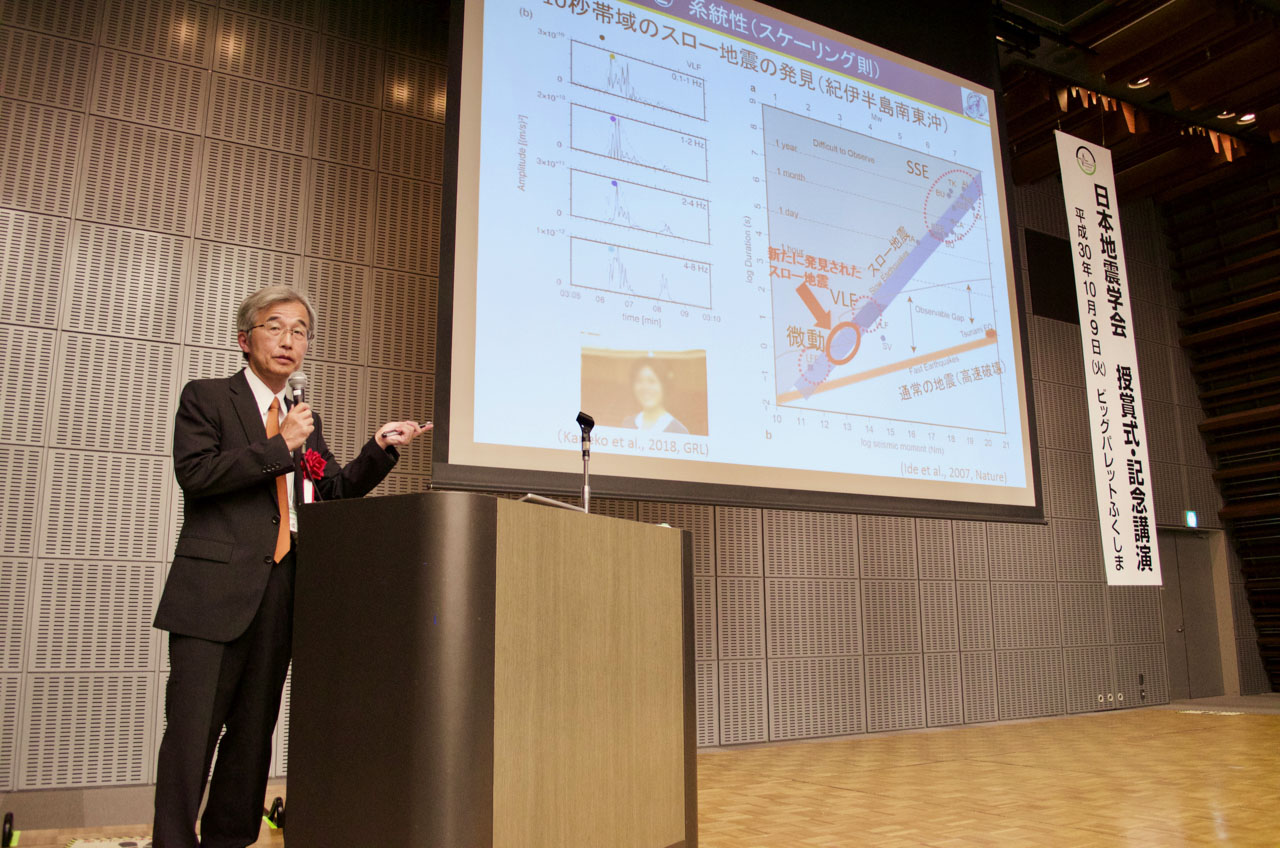
2018/06/03-08
AOGS (Asia Oceania Geosciences Society) 15th Annual Meetingでスロー地震学関連セッションを開催しました。
| 学会名 | AOGS 15th Annual Meeting (公式WEB) |
|---|---|
| 日時 | 2018年6月3-8日 |
| 投稿締切 | 2018年1月19日 |
| 会場 | Hawaii Convention Centre, Honolulu, Hawaii |
| 詳細 | スロー地震学関連セッション: SE27: Modeling of Slow and Regular Earthquakes |
6月4日(月)から6月8日(金)まで、アメリカ合衆国ハワイ州ホノルルで行われたアジアオセアニア地球科学会(AOGS)にて、三井・有吉・麻生・矢部がコンビーナとなり、セッション「Modeling of Slow and Regular Earthquakes」が行われた。6月7日(木)にポスターセッションが開催され、6月8日(金)の午前には口頭セッションが行われた。地震波解析・数値モデリング・岩石実験と、多岐にわたる発表があり、幅広い分野の研究者による議論が行われた。6月7日(木)の固体分野の全体レクチャーでは、ハワイ大学のMichael O. Garcia教授によるキラウエア火山の最新の情報が報告され、動画も交えて興味深い話を聞くことが出来た。会期中には、ハワイ大学のBruce M. Howe教授の研究室訪問(案内:有吉)も行った。今回はアメリカ合衆国ハワイ州で開催されたことから、米国本土からの参加者も多く、世界中の研究者と議論することが出来た。
2018/06/01
「スロー地震学特別セミナー」を開催しました。
Dr. Stephen Kirby(Scientist Emeritus and Senior Scientist, U.S. Geological Survey)によるセミナーを開催します。どなたでも参加可能です。
| 日時 | 2018年6月1日(金)15:00~16:00 |
|---|---|
| 会場 | 東京大学地震研究所1号館2階セミナー室:アクセスMAP |
| 話者 | Dr. Stephen Kirby(Scientist Emeritus and Senior Scientist, U.S. Geological Survey) |
| タイトル | "Fluid Fluxes from Dehydrating Serpentinized Forearc Mantle: Possible Roles in Non-Volcanic Tremor and Related Phenomena" |
2018/05/31
「スロー地震カフェ in 横浜」を開催しました。
話題提供者は、SCRIPPSのChristopher Johnsonさんです。
多くの皆さんのご参加をお待ちしております。
| 日時 | 2018年5月31日(木)11:00~12:00 |
|---|---|
| 会場 | 海洋開発研究機構 横浜研究所 ゲストハウス:アクセスMAP |
| 話題提供者 | Christopher Johnsonさん(SCRIPPS, University of California San Diego) |
| 話題 | "Climate modulated water storage, the deformation, and California earthquakes" |
JpGU2018のスロー地震学のセッションにご招待した、SCRIPPSの Christopher Johnson博士をJAMSTEC横浜研究所にお招きして、 スロー地震カフェを開催しました。
セミナーでは、陸水による微小な荷重の変化と地震活動の関係について詳しく紹介されました。カリフォルニアにおける降水、降雪等による荷重の季節変化とGPSによる地殻変動の関係のモデル化、地震活動との相関について紹介され、荷重による応力の微小な変化がnear failure状態にある断層破壊をトリガするという解釈について説明されました。応力変化の周期によって位相のずれ方が異なると言った興味深い話題もあり、地殻応力と普通の地震およびスロー地震の活動の関係を探る上で大変興味深い話題であると思いました。
また、セミナーの前の時間にはJAMSTECにおける地震・津波研究やDONET観測システム、DONET観測によって得られたVLF地震の研究等について博士に紹介し、興味を持って聞いていただき、スロー地震の発生メカニズム等について議論を行いました。
セミナー後は有志が昼食時まで共にし、会食しながらセミナーの内容についてのさらに詳しい議論やアメリカにおける研究環境など、貴重な話を伺うことが出来ました。
2018/05/20-24
JpGU2018でスロー地震学関連セッションを開催しました。
| 学会名 | JpGU2018 (公式WEB) |
|---|---|
| 日時 | 2018年5月20-24日 |
| 投稿締切 | 2018年2月19日 |
| 会場 | 幕張メッセ |
| 詳細 | スロー地震学関連セッション: S-CG53: Science of slow earthquakes スロー地震学ブース: A55 |
2018/04/10
東工大 中島淳一教授、東北大 内田直希准教授の論文がNatureのresearch highlightsに選ばれました。
東工大プレスリリースはこちらから
2018/03/25
文部科学省科学研究費助成事業新学術領域研究「核-マントルの相互作用と共進化」ならびに「スロー地震学」共催一般公開講演会が開催されました。
愛媛大プレスリリースはこちらから
| 日時 | 2018年3月25日(日)15:30~17:35 |
|---|---|
| 会場 | 愛媛大学南加記念ホール |
| 詳細 | 物理で明かす地球の深部、化学でひも解く地球の歴史、地震で探る日本の地下
|
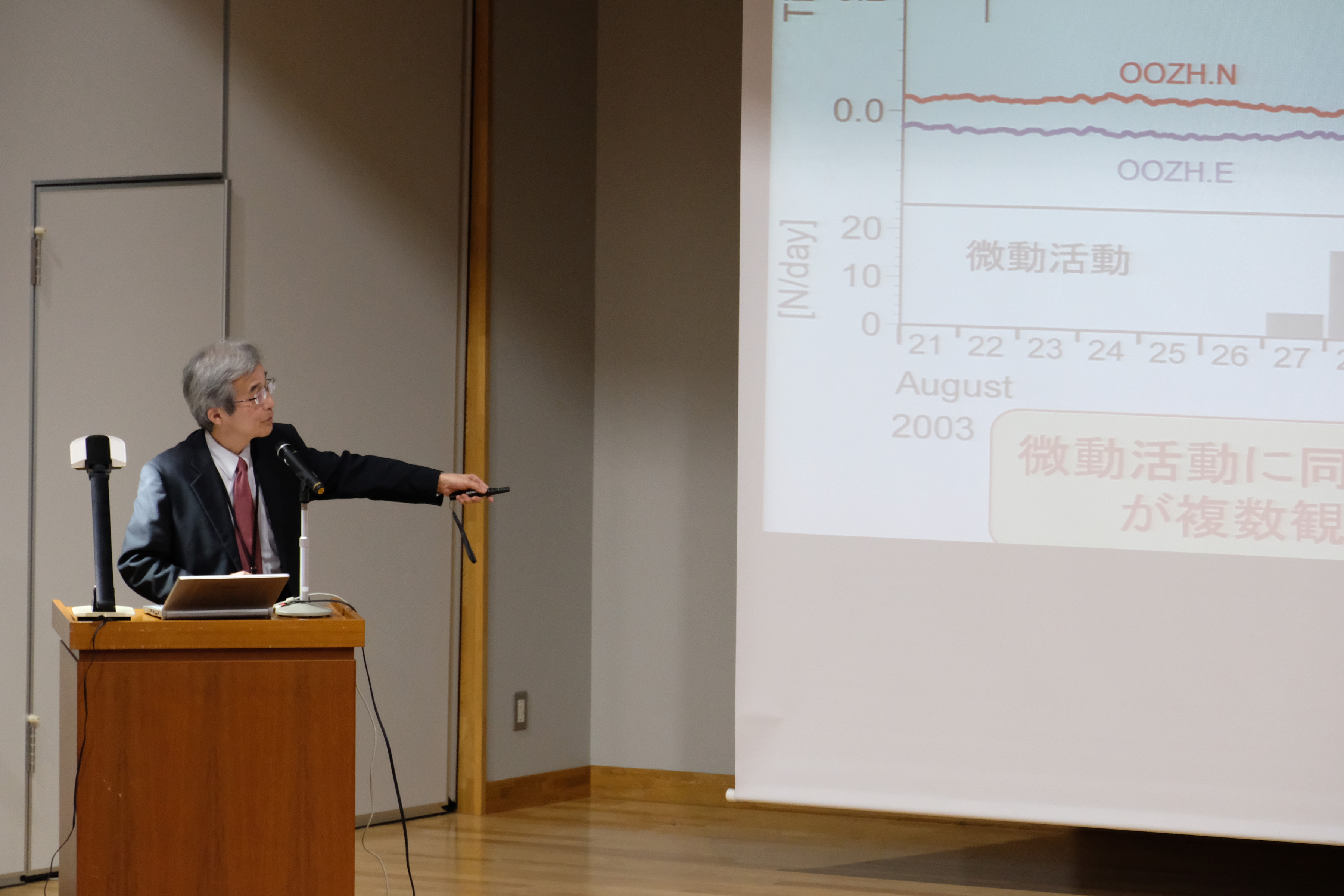
2018/03/15
C02班研究会を開催しました。
| 日時 | 2018年3月15日-16日 |
|---|---|
| 会場 | 神戸大学 自然科学総合研究棟3号館609号室(6階):アクセスMAP |
| 詳細 |
3月15日(木)
|
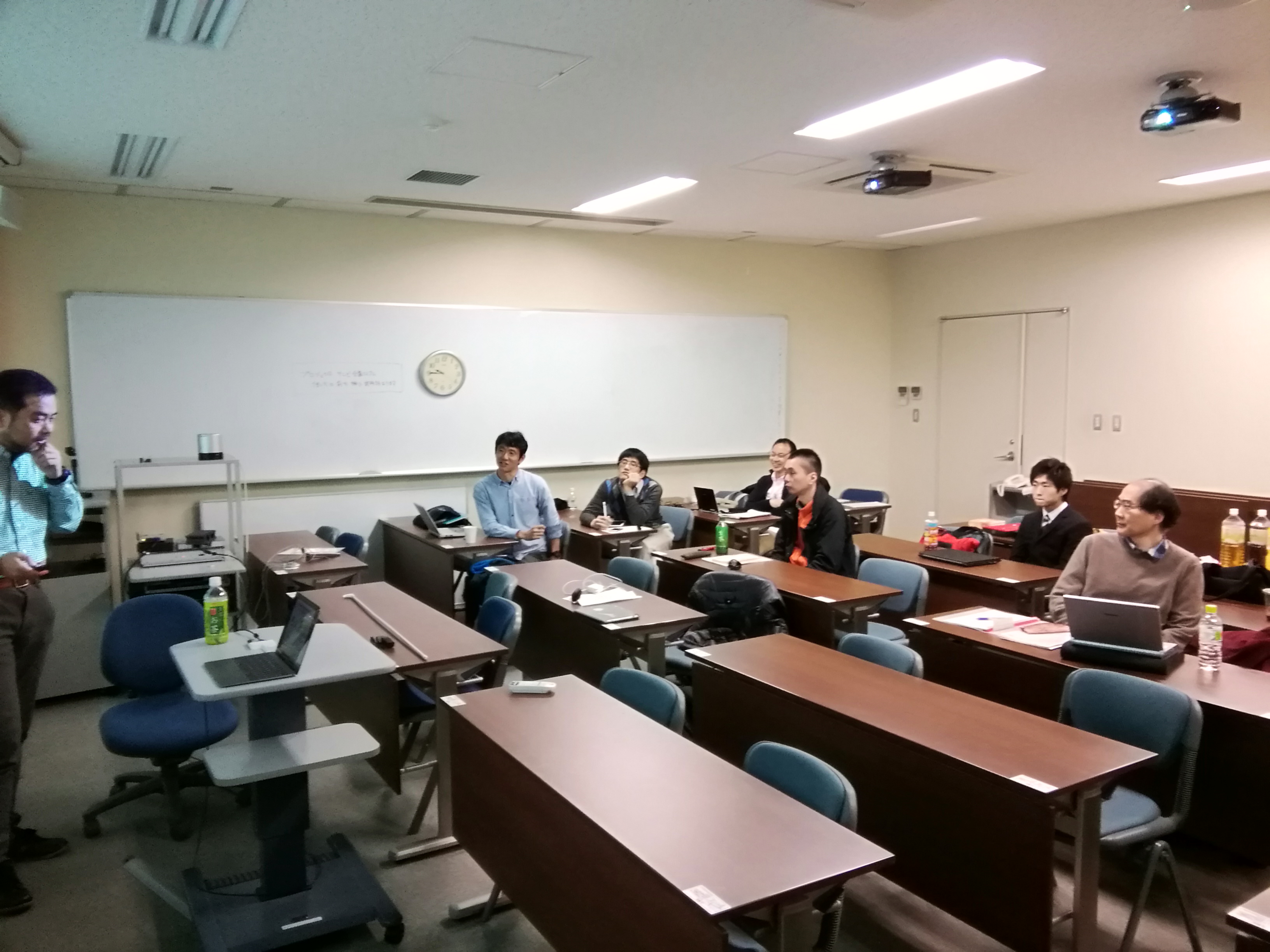
2018/03/14
「スロー地震カフェ」を開催しました。
今回の話題提供者は、海洋研究開発機構の堀高峰さんです。
多くの皆さんのご参加をお待ちしております。
| 日時 | 2018年3月14日(水)14:00~16:00 |
|---|---|
| 会場 | 東京大学地震研究所1号館セミナー室:アクセスMAP |
| 話題提供者 | 堀 高峰さん(海洋研究開発機構) |
| 話題 | 「沈み込み帯での巨大地震とゆっくり地震発生過程の理解と予測のためのHPCの活用:現状と展望」 |
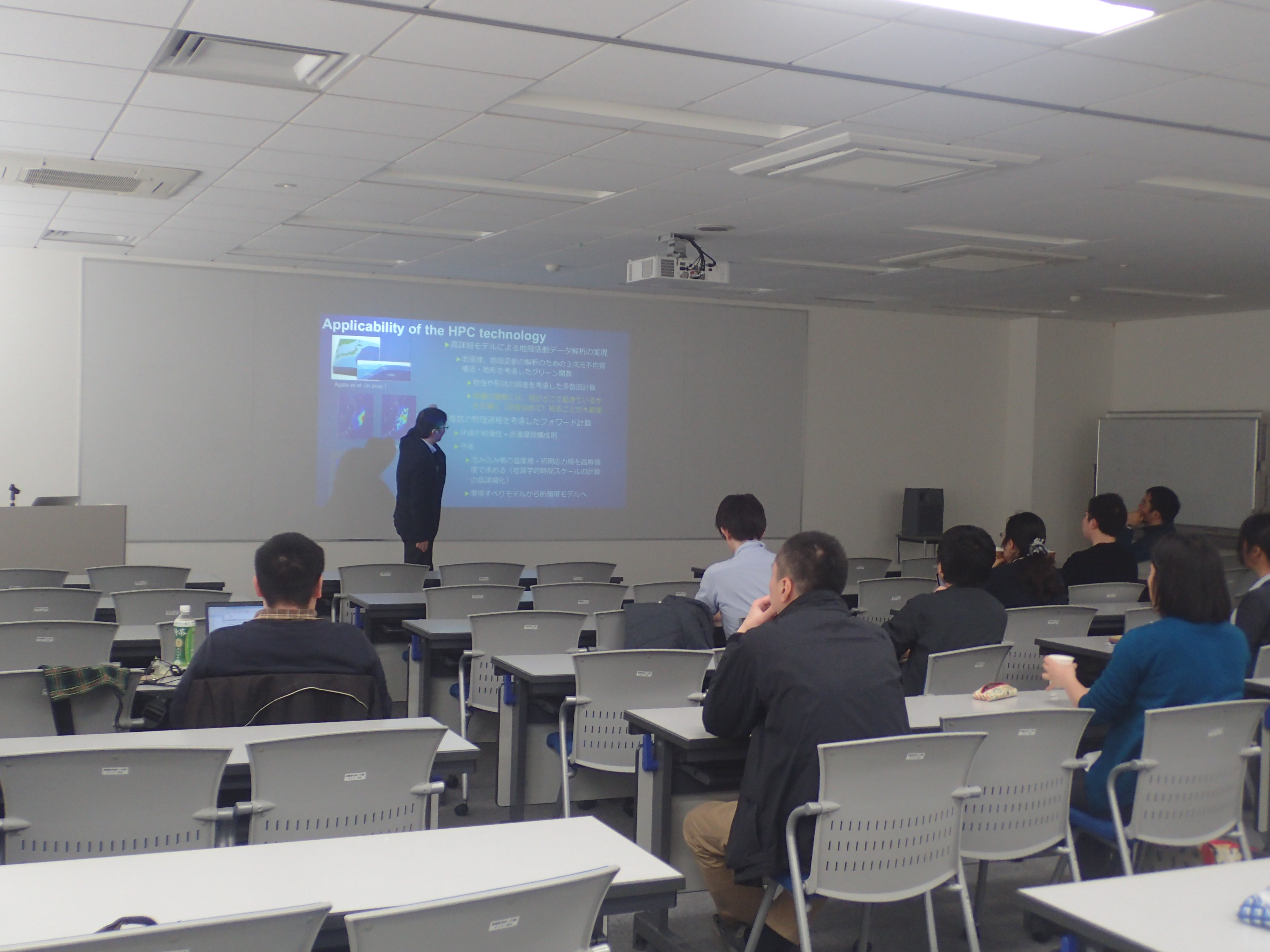
2018/03/13
「スロー地震カフェ in 仙台」を開催しました。
「スロー地震カフェ」を東北大学で開催します。
話題提供者はNatalia Poiataさん(IPGP, ルーマニア国立地球物理研究所)です。多くの皆さんのご参加をお待ちしております。
| 日時 | 2018年3月13日(火)13:30~15:00 |
|---|---|
| 会場 | 東北大学合同C棟4Fセミナー室, S407 |
| 話題提供者 | Natalia Poiataさん(IPGP, ルーマニア国立地球物理研究所) |
| 話題 | An automated multi-scale, network-based method for detection and location of seismic sources: application to regular and slow earthquakes |
A01班の招聘で東大地震研に滞在中のNatalia Poiata博士を東北大学にお招きして、仙台で初の(東大地震研以外では二度目の)スロー地震カフェを開催しました。
今回のセミナーでは、新しい震源決定手法であるBackTrackBB(Poiata et al., 2016)について詳細にご紹介いただいた後、同手法を用いて検出した通常の地震およびスロー地震活動について、最新の成果を交えて解説いただきました。
東北大学では(東大地震研に比べて)スロー地震になじみが少ない方が多いですが、導入部を丁寧にご説明いただき、また講演資料を配布したこともあり、非常に活発な議論が交わされました。
セミナー後は、火山活動に伴う地震の震源決定に関する研究など東北大学で行っている個々の研究に関して教員や学生を交えて2時間ほど個別に議論を行いました。
Natalia Poiata博士には短い滞在時間のほとんどを議論に費やしていただき、お疲れだったかもしれませんが、セミナー後に参加者の方から非常にインスパイアされたとのコメントをいただき、有意義な時間だったのではないかと思います。
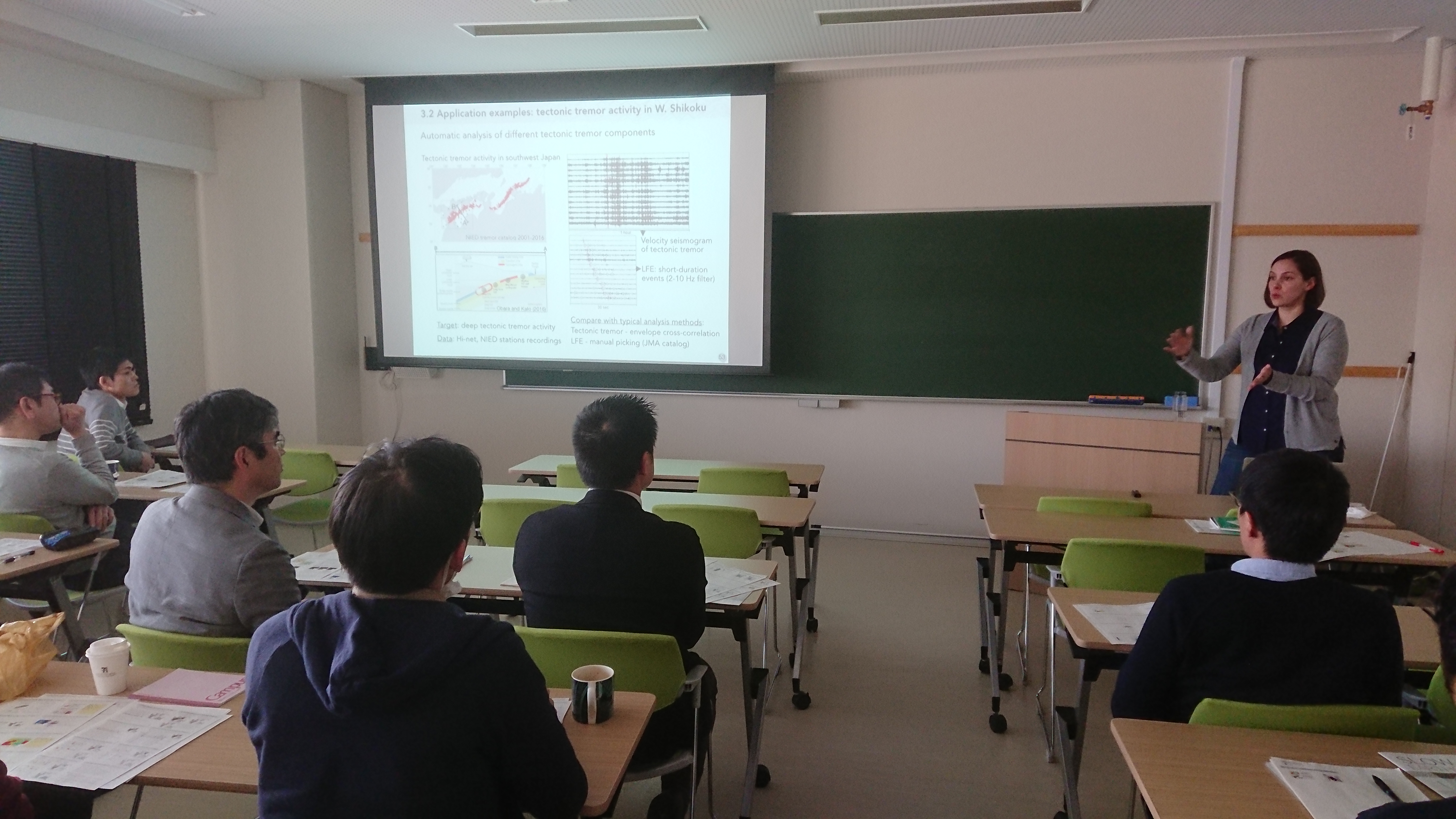
2018/03/07
C01班研究集会を開催しました。
| 日時 | 2018年3月7日-8日 |
|---|---|
| 会場 | 静岡大学(静岡キャンパス) 共通教育C棟611室 |
| 詳細 |
3月7日(水)
|
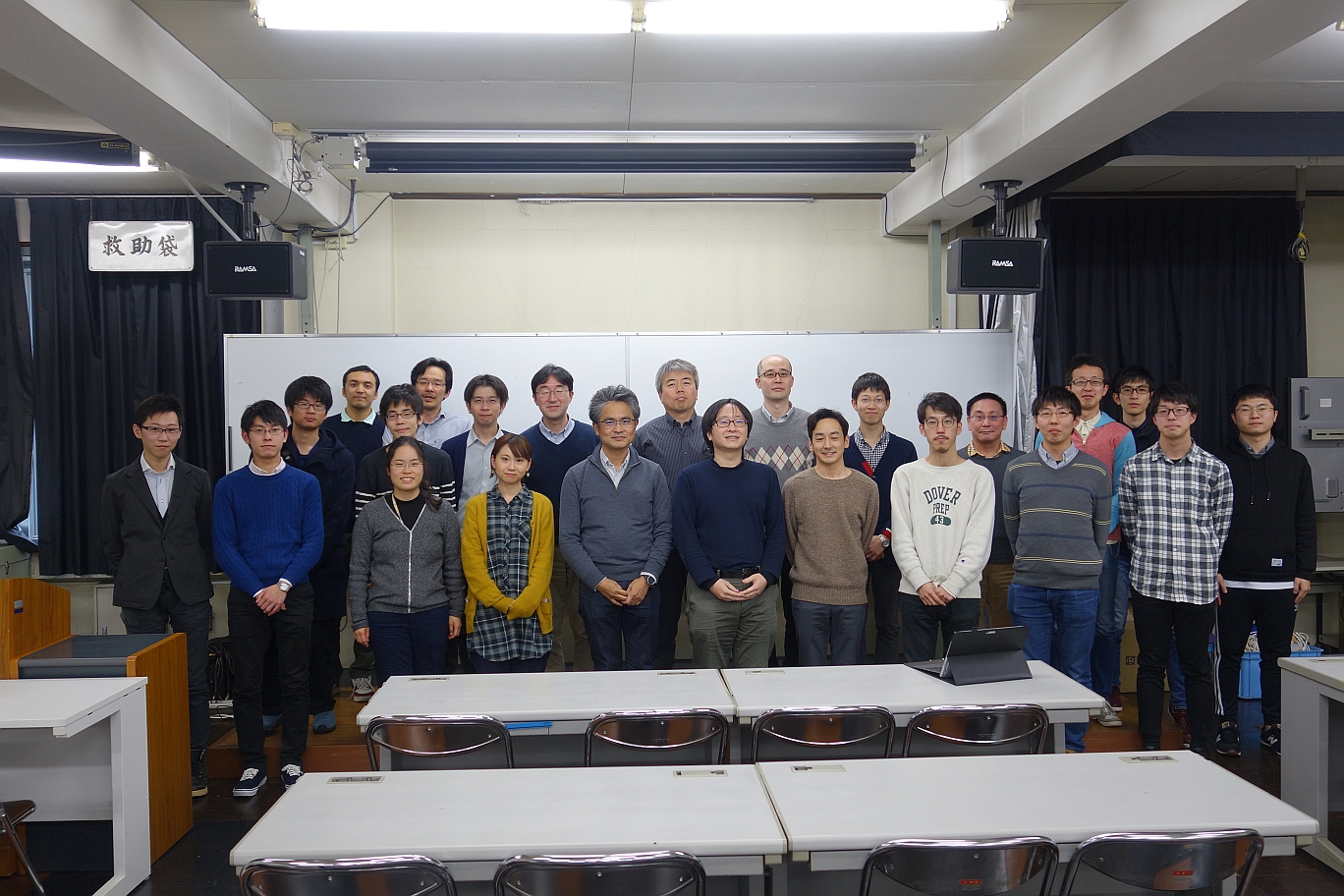
2018/2/26-27
ニュージーランド押しかけワークショップ"New Zealand-Japan Joint workshop on Slow Slip"を開催しました。
| 日時 | 2018年2月26-27日 |
|---|---|
| 場所 | Wellington, New Zealand |
| 会場 | VUW, Rutherford House |
| 詳細 | プログラム 2/28-3/2: Kaikoura巡検 2/28: Wellington断層巡検 |
2月26,27日の2日間にかけて、延べ120名、65名の参加を得て、ビクトリア大学ウェリントン校のラザフォードハウスにて、第一回押しかけワークショップ「New Zealand-Japan Joint Workshop on Slow Slip」が行われた。
65名の参加者のうち、日本からの参加者は27名、ニュージーランドからはビクトリア大学から13名、GNS Scienceから15名、さらにオタゴ大学やNIWA、さらにはニュージーランドの行政関係機関である地震委員会(Earthquake Commission)からの参加者があった。 また、ケンブリッジ大学(英)やコロンビア大学(米)からの参加者も見られた。研究発表に先立ち、ビクトリア大学のギルフォード副総長および高田駐NZ日本大使から、日本-NZ共同研究の更なる発展を期待されるとの歓迎の挨拶をいただいた。
研究発表では、日本から15件、ニュージーランドから14件、およびアメリカから1件の口頭発表、また、日本から12件、ニュージーランドから4件のポスター発表があり、それぞれ活発な質疑応答が行われた。 研究発表後のディスカッションでは、主として共同研究の活性化についての議論が行われ、共同して行う調査観測、およびデータの有効利用、さらには学生交流プログラムを利用した人材交流について話し合われた。
ワークショップ後は、NIWAやGNS Scenceを訪問した後,ウェリントン断層を観察するウェリントン近郊コースと、2016年Kaikoura地震の断層周辺を見るニュージーランド南島コースの巡検が行われ、日本側からはそれぞれ9名が参加した。
一方、東京大学地震研究所の望月公廣と京都大学防災研究所の伊藤嘉宏は、2月28日にビクトリア大学ウェリントン校にて、3月1日にNPOのEast Coast LABの主催でネイピアの国立水族館にて、一般講演を行った。それぞれ29名、78名の聴衆があった。本講演について、ニュージーランド・ヘラルドのインタビューを受け、3月7日の朝刊に記事(リンク)が掲載された。
参加者からは、日本、ニュージーランド問わず、ワークショップ、巡検、一般講演ともに非常に有意義であったとの感想が聞かれた。
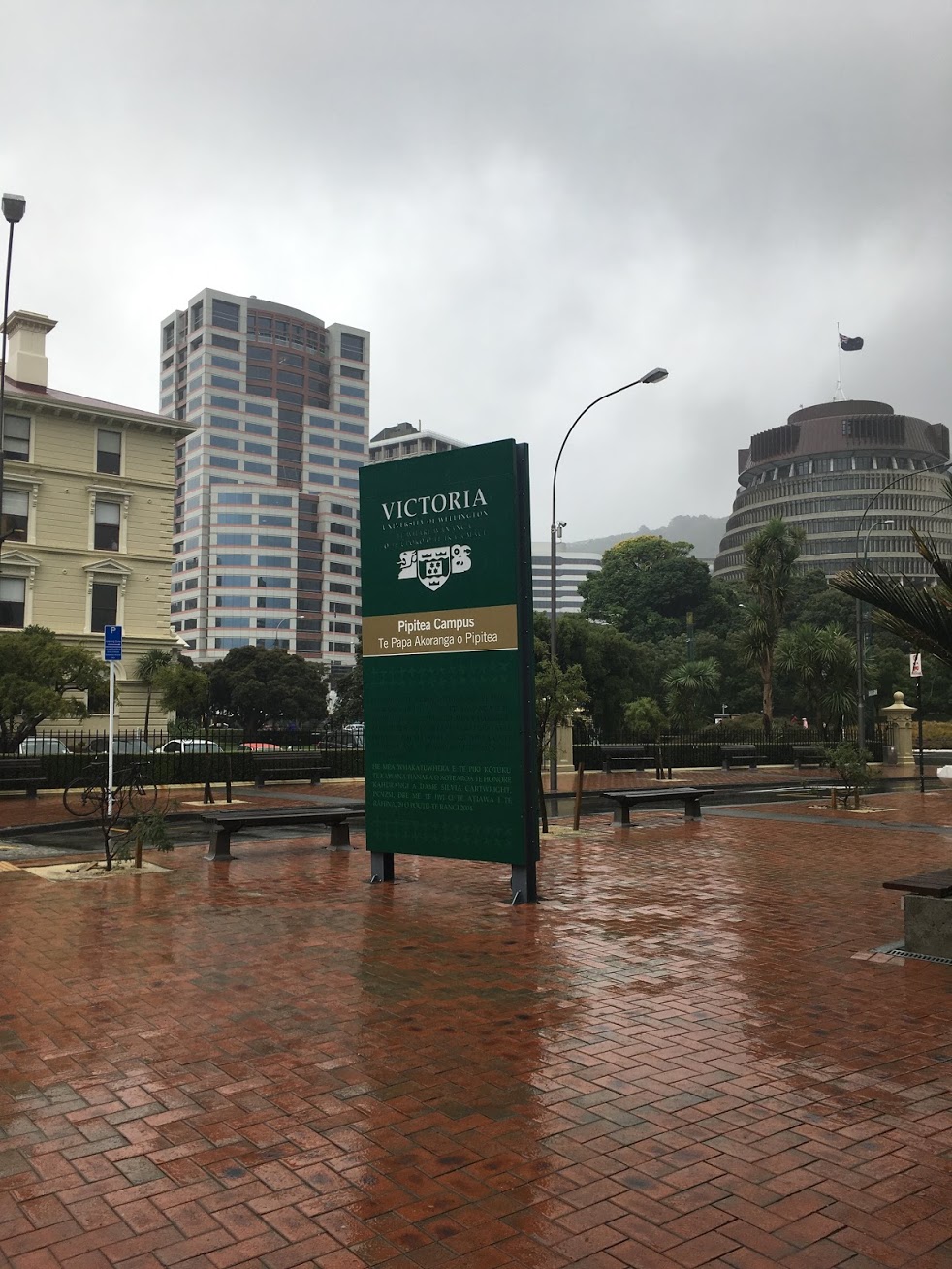
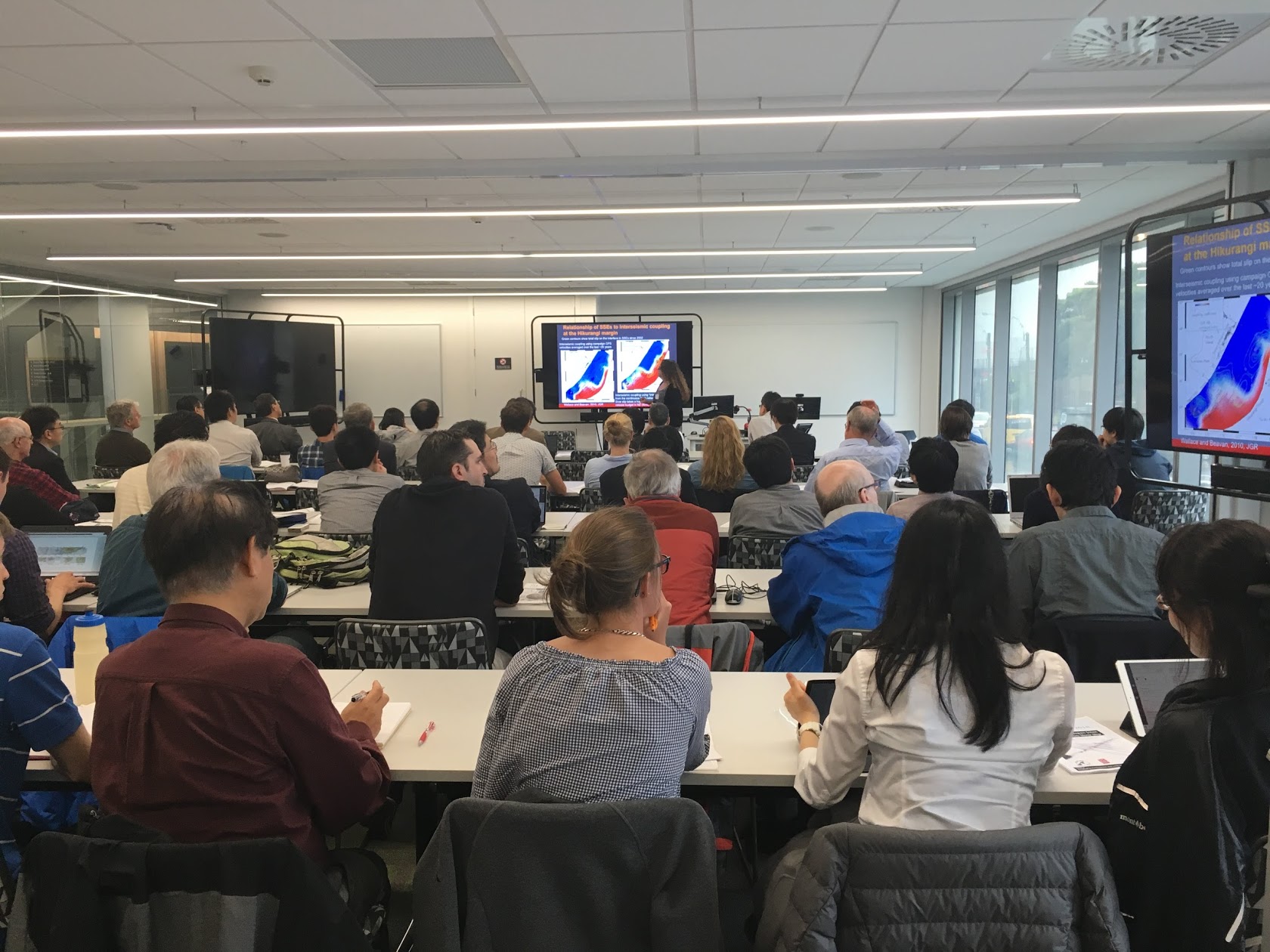
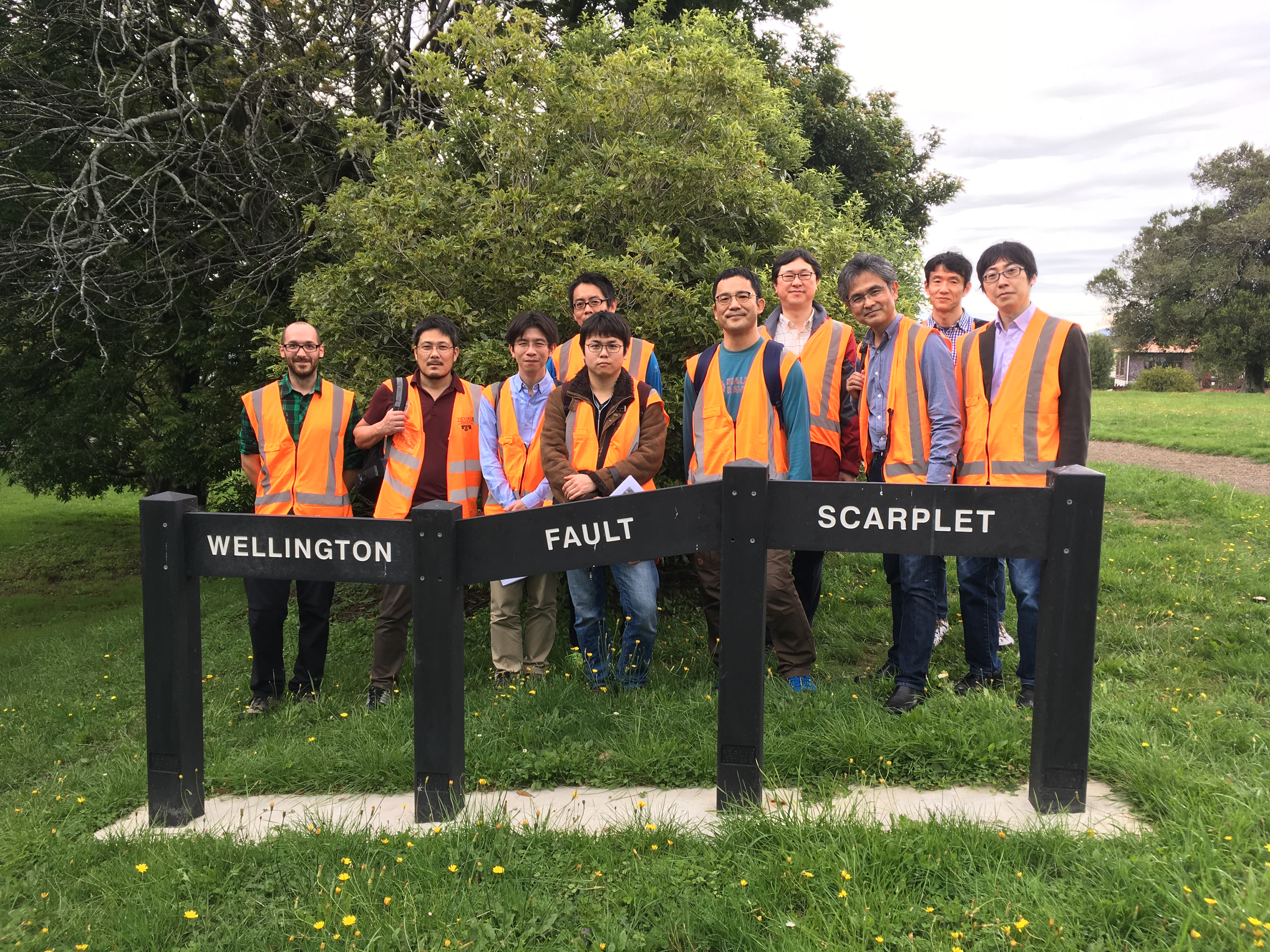
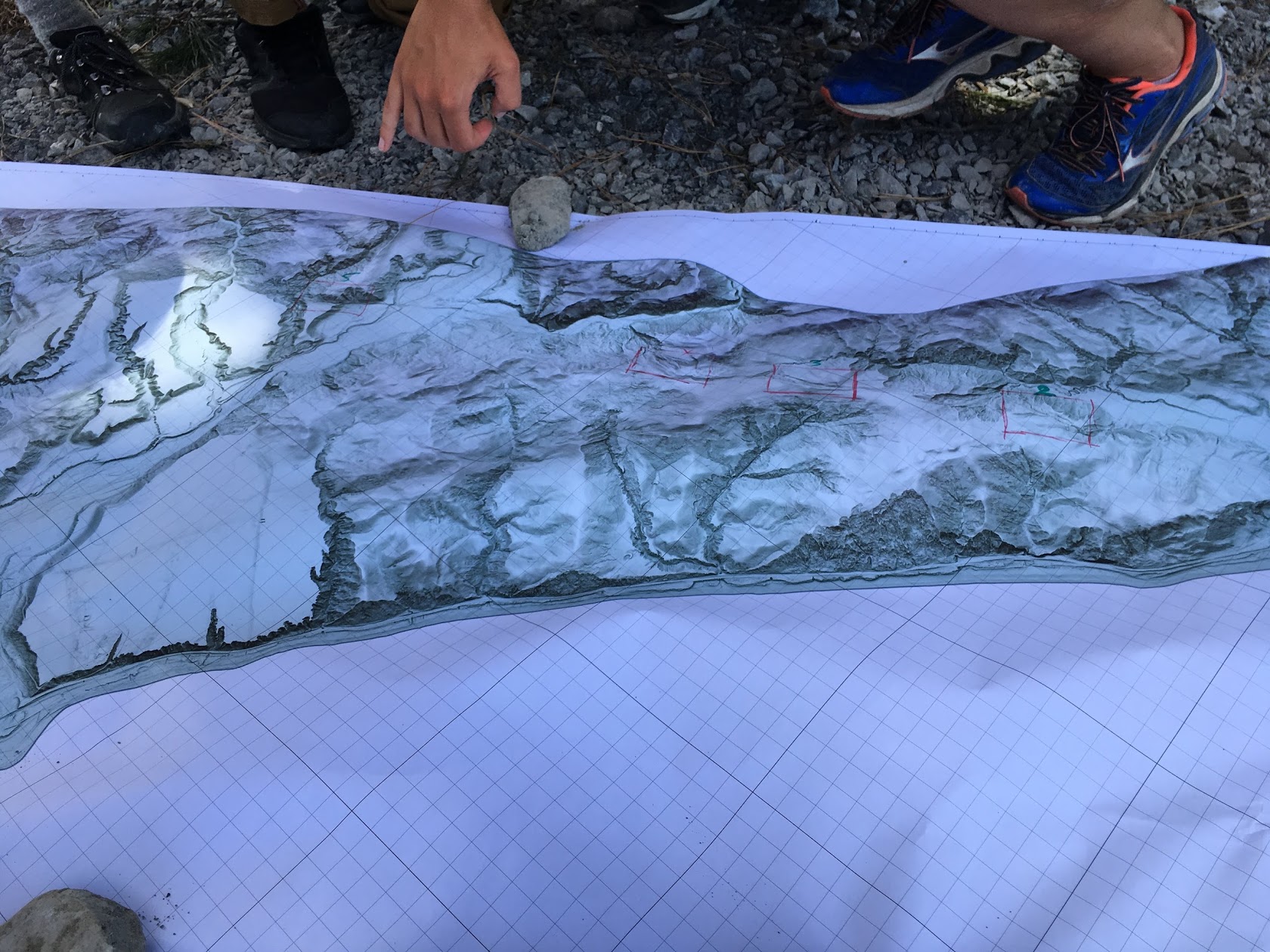
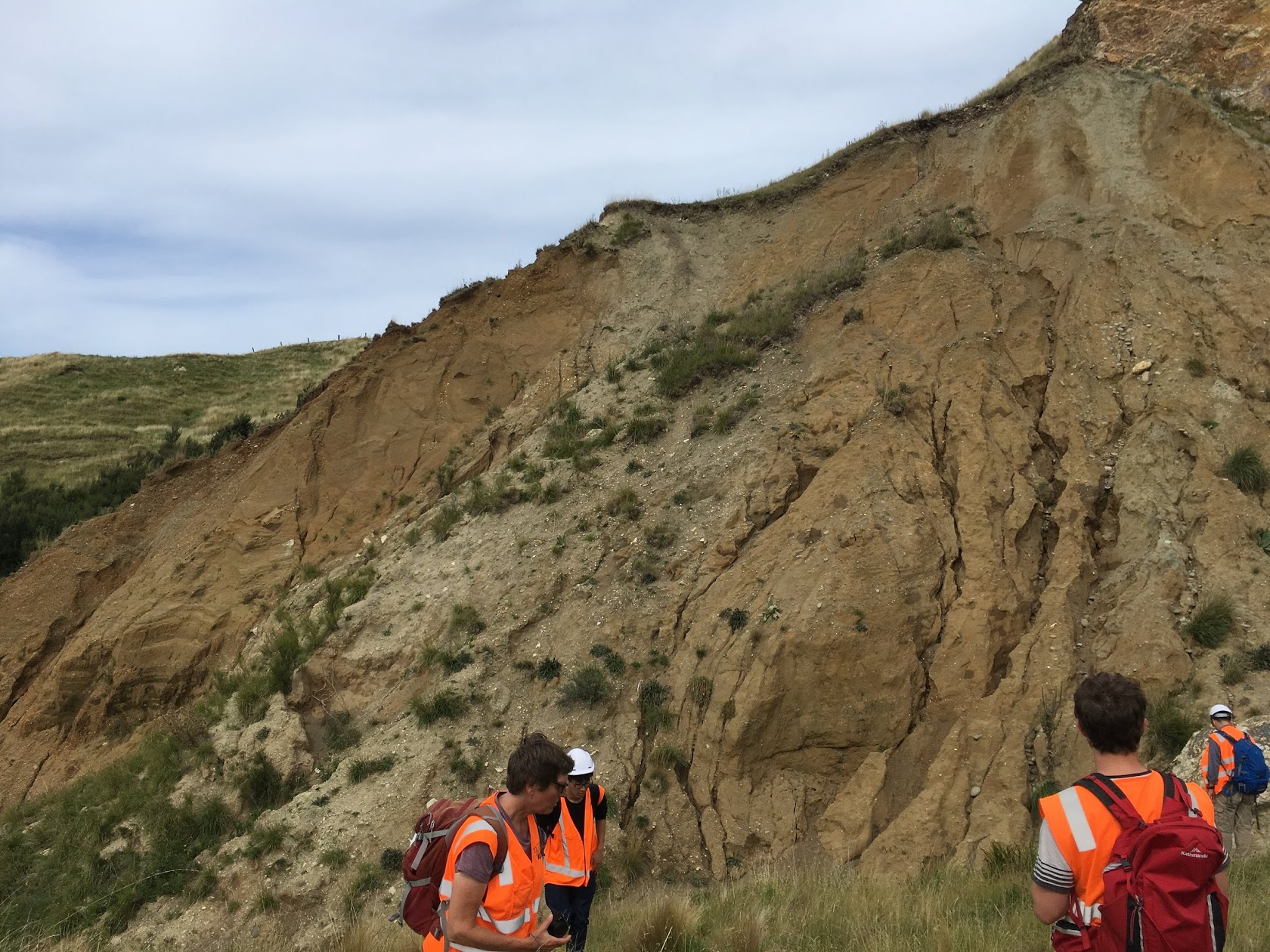
2018/02/21
「スロー地震学A01特別セミナー」を開催しました。
A01班で東大地震研究所に招聘中のフランスIPGPおよびルーマニア国立地球物理研究所研究員のNatalia Poiata博士によるセミナーを開催します。どなたでも参加可能です。
| 日時 | 2018年2月21日(水)15:00~16:00 |
|---|---|
| 会場 | 東京大学地震研究所1号館2階セミナー室:アクセスMAP |
| 話者 | Dr. Natalia Poiata(IPGP, ルーマニア国立地球物理研究所) |
| タイトル | An automated multi-scale network-based scheme for detection and location of seismic sources |
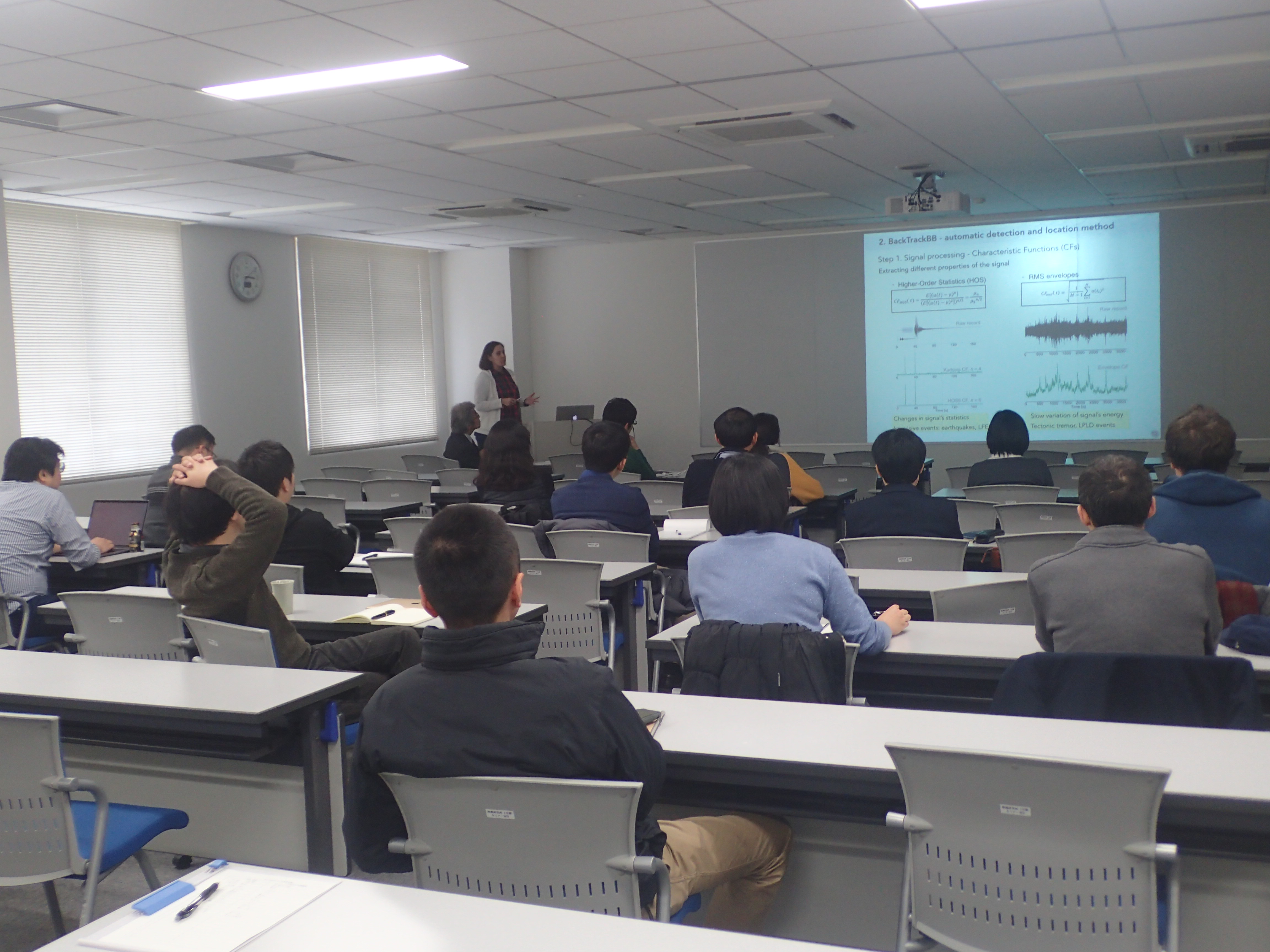
2018/02/19
「地震活動の物理2018」
| 日時 | 2018年2月19日(月) 10:00~17:30 |
|---|---|
| 会場 | 東京大学地震研究所2号館第一会議室:アクセスMAP |
| 詳細 |
「相似地震の再来間隔モデルと東北太平洋沖の準静的すべり履歴の推定」 「破壊プロセスの不確定性と地震現象の多様性をつなぐ断層破壊シミュレーション」 「ランダムネスをもつバネブロックモデルと自己組織化臨界現象」 「材料の塑性現象における地震に類似した変形挙動の原子シミュレーション」 「地震群からの特徴量抽出に基づく前震識別モデルの検討」 |
2018/01/12
「金曜日セミナー」、「スロー地震カフェ」を開催しました。
「金曜日セミナー」と、1月の「スロー地震カフェ」のご案内です。
今回の話題提供者は、海洋研究開発機構の中田令子さんです。
「金曜日セミナー」でお話しいただいたあと、同じテーマで引き続き「スロー地震カフェ」でお話しいただきます。
多くの皆さんのご参加をお待ちしております。
| 日時 | 2018年1月12日(金) 金曜日セミナー:15:00~16:00 スロー地震カフェ:16:15~17:30 |
|---|---|
| 会場 | 金曜日セミナー:東京大学地震研究所1号館会議室 スロー地震カフェ:東京大学地震研究所1号館事務会議室AB:アクセスMAP |
| 話題提供者 | 中田令子さん(海洋研究開発機構) |
| 話題 | 「スパースモデリングで得られた豊後水道長期的スロースリップの空間分布/ Geodetic data inversion for spatial distribution of long-term slow slip events beneath the Bungo Channel using sparse modelling」 |
